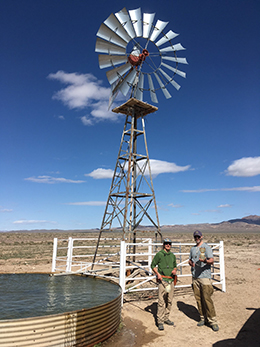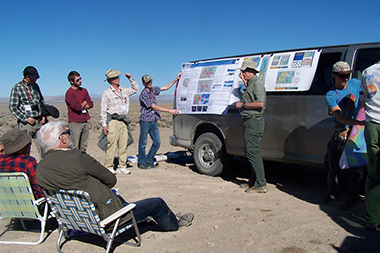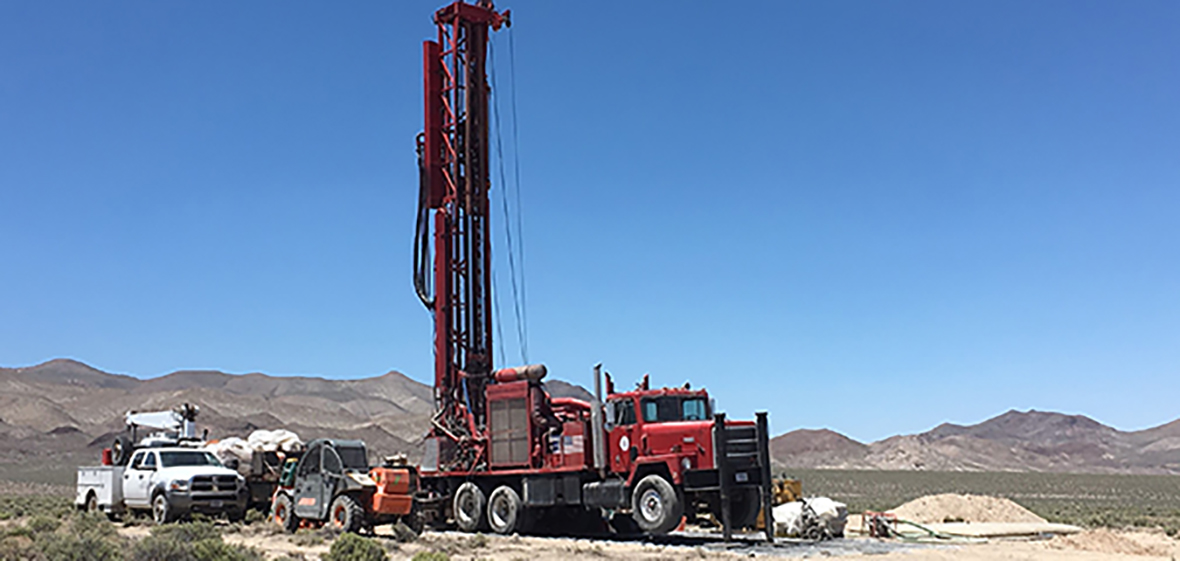Geothermal power potential in Nevada is heating up – with two successful discoveries in the Great Basin by the Nevada Bureau of Mines and Geology using a previously untried method for finding unknown, hidden geothermal resources.
Both discovered systems are blind – meaning there are no surface indications of hot water – and there had been no exploration previously in one of these areas and only minor previous exploration in the other. Geologists at the Nevada Bureau of Mines and Geology at the University of Nevada, Reno, used a number of other surface and subsurface clues in their methodology developed as part of their Department of Energy funded Play Fairway project that has been underway since 2014.
“The exploration, the mapping, the analysis, all led us to the top two spots – of perhaps hundreds of potential sites – to drill geothermal wells,” Jim Faulds, director of the Nevada Bureau of Mines and Geology, said. “Success at two sites provides an initial validation of the methodology we developed, and opens up new possibilities for power generation sites by the industry.”
The third and final phase of the project involved temperature-gradient drilling generally to approximately 500 foot depths. Data from all three phases of the project has been analyzed and will help guide industry to the most favorable sites to generate renewable energy in the large study area, which covers about one-third of the state of Nevada. Measurements from the new geothermal wells have been completed, the wells capped and waiting for industry to step in. Now that these blind geothermal systems have been discovered, it’s up to the geothermal industry to conduct additional drilling for possible development of a geothermal power plant.

Graduate students sample for geochemistry in warm well in Granite Springs Valley
Geothermal energy is one of the more stable types of alternative energy, with the system extracting hot water from underground, bringing it to the surface exchanging the heat to create electrical power, then returning it to the deep underground aquifer. This is a 24/7 process that isn’t reliant on sunshine, wind or battery technology.
New Geothermal Systems Ready for Industry
“It’s gratifying to demonstrate positive results of applied science here at the Bureau,” Faulds said. “After several years of research, mapping and analysis, we’ve identified many promising areas that have great potential for geothermal power. Funds only allowed for test drilling at two sites, but there are dozens of other promising sites that I’m excited about across the region. The two sites, one in southeastern Gabbs Valley and the other in at northern Granite Springs Valley, are now ready for industry to decide on their economic viability.”
McGinniss Hills, currently the largest geothermal system in Nevada northeast of Austin, produces about 140 megawatts of electrical power and is also a hidden geothermal system with no surface hot springs or steam vents. The newly discovered system in southeastern Gabbs Valley system is probably not as large as that at McGinniss Hills, but Faulds thinks that it is likely that many other systems as large as McGinniss are yet to be discovered.
“There is potential in the Great Basin for much greater amounts of geothermal energy than the current 720 MW of capacity from about 25 power plants already in place,” Faulds said. “The geothermal wealth of this region can be attributed to its active faulting and thinning of the crust, which allows hot fluids to rise more quickly to levels accessible through drilling. The Play Fairway project provides a catalyst for accelerating geothermal development in the region.
“The industry is now looking at Gabbs. It’s not our job to develop the resource, but rather to assess geothermal resources and identify the systems, so industry can take over and develop energy for Nevada and neighboring states.”
The play fairway method includes the study of many geological and geophysical attributes of a region, including the location of earthquake faults. In Gabbs Valley, there is a major subsurface fault intersection. Most geothermal systems in the Great Basin are affiliated with Quaternary faults, faults that have been recognized at the surface and that have moved in the past million years or so, a portion of the Quaternary time period.

Nevada Bureau of Mines and Geology Director Jim Faulds gives a field lecture about geothermal resources
After determining the best places to drill in 2018, Faulds and his team worked with a crew from the U.S. Geological Survey to drill a series of wells across the geothermal system. Six holes each were drilled at both the Gabbs and Granite Springs Valley sites.
“We bracketed the system with drilling to better define its size and potential power capacity,” Faulds said.
The Granite Springs site is not as well defined as Gabbs.
“It wasn’t a bullseye like Gabbs, finding the center was harder,” Faulds said. “It might require more drilling to pinpoint, but both systems are quite hot at relatively shallow depths, 124 degrees Centigrade (255 degrees Fahrenheit) at 500 feet at Gabbs and 95 degrees Centigrade (203 degrees Fahrenheit) at similar depths for Granite Springs Valley. Geochemical data suggest higher temperatures for each site at greater depths.”
Much of the Gabbs Valley project was carried out by Jason Craig for his master’s thesis. This project was a great collaborative effort, Faulds said, between several Bureau of Mines and Geology faculty and graduate students at the University, as well as several other organizations, such as the U.S. Geological Survey.
This project was funded by a Department of Energy grant through their Geothermal Technologies Office. Collaborations with the geothermal industry, including Ormat, Nevada Inc. and U.S. Geothermal were also beneficial to this study.
The DOE has funded multiple play fairway analysis studies throughout the United States, going back to 2014, and several institutions around the west have developed their own play fairway methods. The DOE program started with about 10 separate funded projects, and five were selected to continue work in the final third phase, including the Bureau of Mines and Geology at the University of Nevada, Reno.
Machine-Learning for Geothermal Exploration
As part of their analysis, Faulds and his team used a few basic machine-learning techniques during the play fairway project, and now have plans to step up this effort with a newly funded project from the DOE. The project is intended to apply artificial intelligence and machine-learning techniques to geothermal exploration to identify previously unrecognized connections between the various datasets.
“This is like icing on the cake of our very successful geothermal play fairway project,” Faulds said. “This new project is aimed at facilitating additional discoveries of geothermal systems in Nevada using machine learning methods and builds on our previous efforts on geothermal play fairways in the region.
“This machine learning project is hopefully the first phase of a long-term, multi-phase program. This first phase is funded at $500,000.”
For this project, Faulds has assembled a team of scientists from the Nevada Bureau of Mines and Geology, USGS and experts in machine learning from MIT and the oil industry. Machine learning is a technique that teaches computers to analyze data, learn from the data and improve their performance through adaptation. The hope is that there will be higher success rates in geothermal exploration leading to greater efficiency and lower costs for geothermal exploration and development.
The mission of the Nevada Bureau of Mines and Geology is to provide the citizens of Nevada with geologic information on geologic hazards and natural resources both to protect the public and facilitate, diversify and enhance Nevada’s economic future. NBMG is a statewide public service unit that applies its expertise to the entire state as a division of the University of Nevada, Reno and resides in the Mackay School of Earth Sciences and Engineering in the College of Science. Since its inception in 1929, it has served as the State Geologic Survey of Nevada and a Bureau of information and analysis for geologic data throughout the state.












